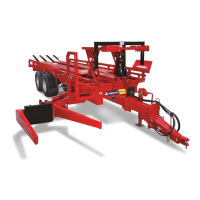64 Operator's Manual – Self-loading Bale Carrier TSR-3450 Anderson Group
Problem Possible Cause Solution
The pusher frame does
not move or moves
slowly.
The loading arm is block-
ing the pusher frame.
Lower the loading arm.
The hydraulic hoses are
incorrectly hooked-up to
the tractor.
Hook them up correctly (see section 3.2
Hydraulic and Electrical System Hook-up).
The loading arm safety
device tap rod (diverter
valve) is not working.
Ensure that the diverter valve tap rod can
move freely and it is correctly adjusted
(the tap rod is raised when the arm is fully
lowered).
The pusher frame’s for-
ward stop position
sensor or the return
sensor is poorly adjusted
or broken.
Ensure that each sensor is correctly adjus-
ted and in good condition. Adjust one or
the other or both, as needed. Replace any
non-functional sensors.
There is a problem with
the pusher frame’s elec-
tric wires, connectors, or
travel limit sensors.
Check the condition of the electric wires
and connectors and replace any damaged
parts.
Check the condition of the pusher frame
travel limit sensors and replace any dam-
aged sensors.
The pusher frame does
not push the bales far
enough and the grab-
ber collides with them
when loading new
bales.
The pusher frame’s
travel limit stop is not
adjusted to the bale
width.
Use the other adjustment available for the
travel limit (see section 4.4 Pusher Frame
Stroke).
The pusher frame
pushes the bales too
far and the bales fall
from too high when
unloading.
The pusher frame’s
travel limit stop is not
adjusted to the bale
width.
Use the other adjustment available for the
travel limit (see section 4.4 Pusher Frame
Stroke).
The pusher frame does
not return auto-
matically.
The electrical connection
is defective.
Check the connection and make any
required changes.
The pusher frame’s cent-
ral stop position and
return sensor is poorly
adjusted or broken.
Ensure that the sensor is correctly adjus-
ted and in good condition. Adjust it as
needed or replace it if it is no longer func-
tional.

